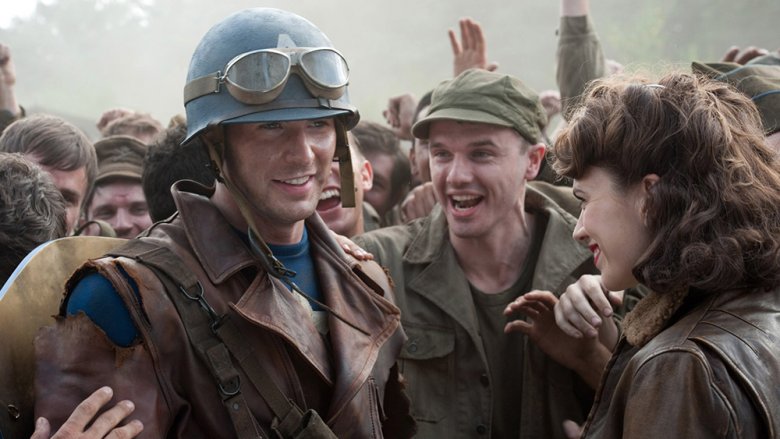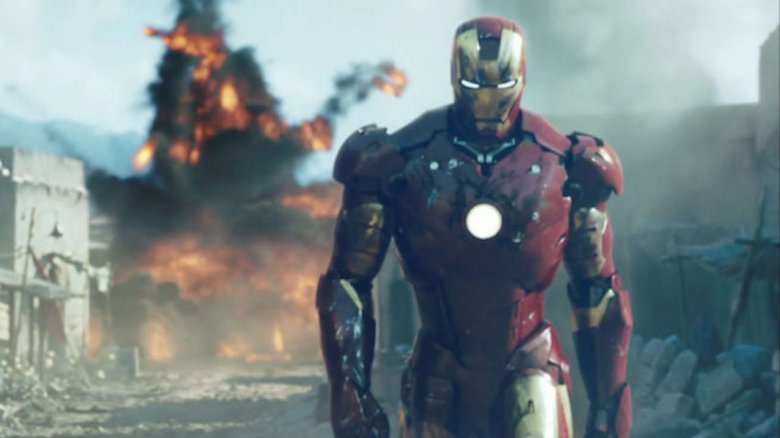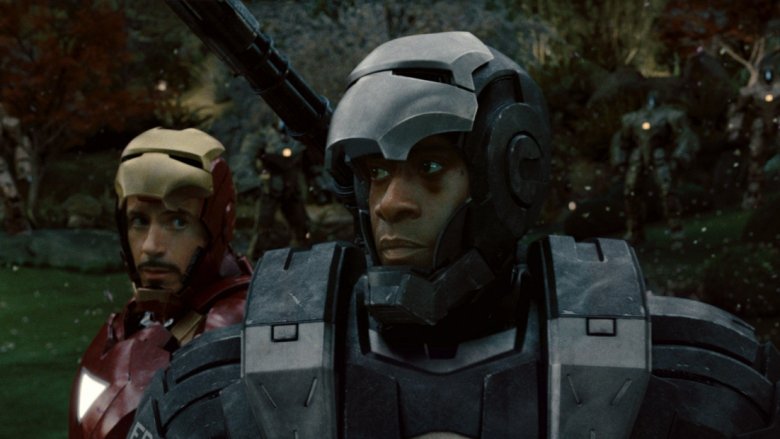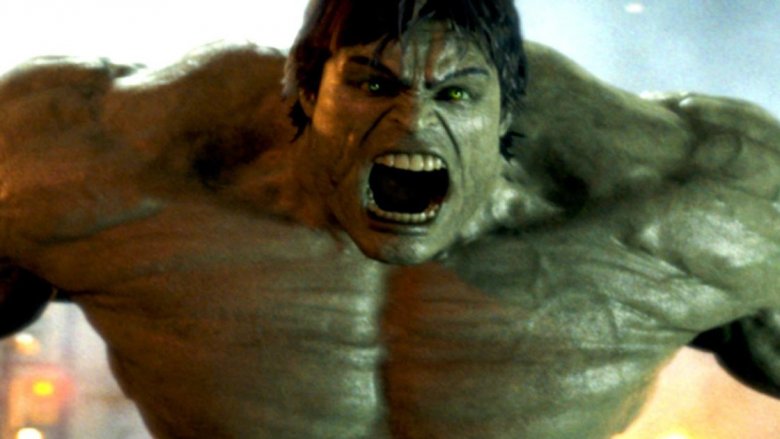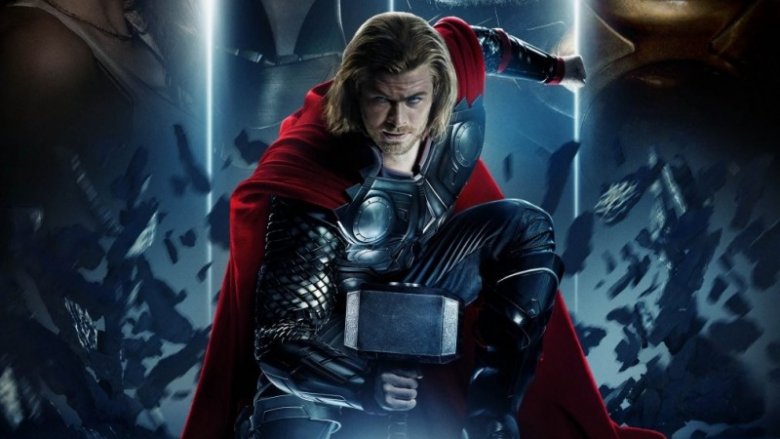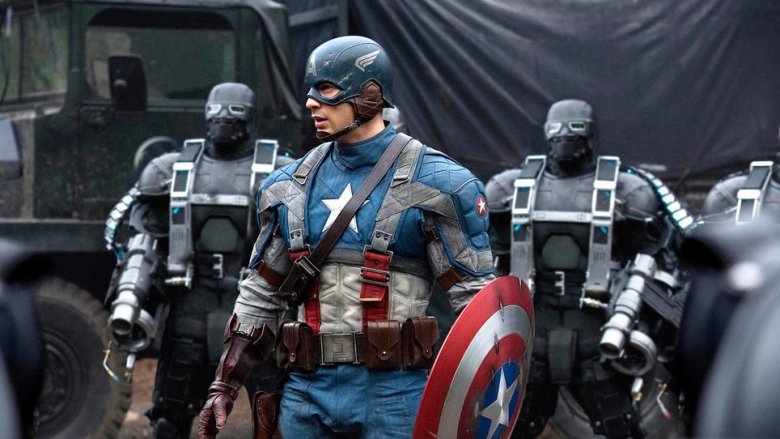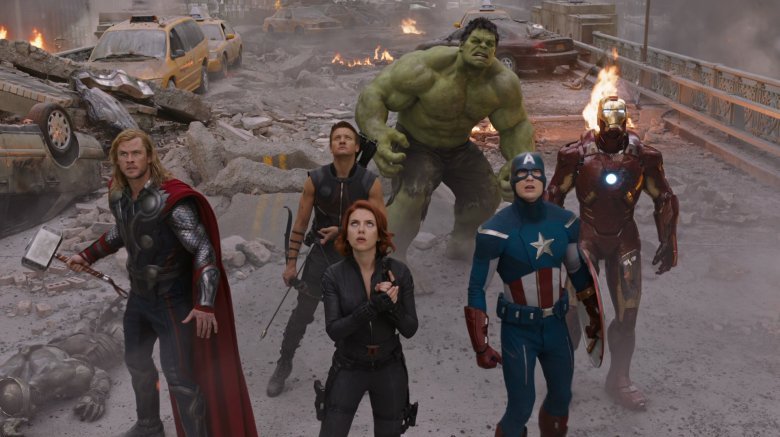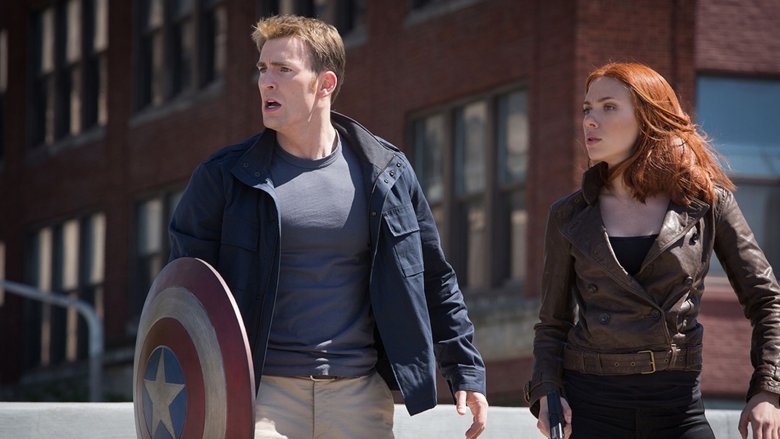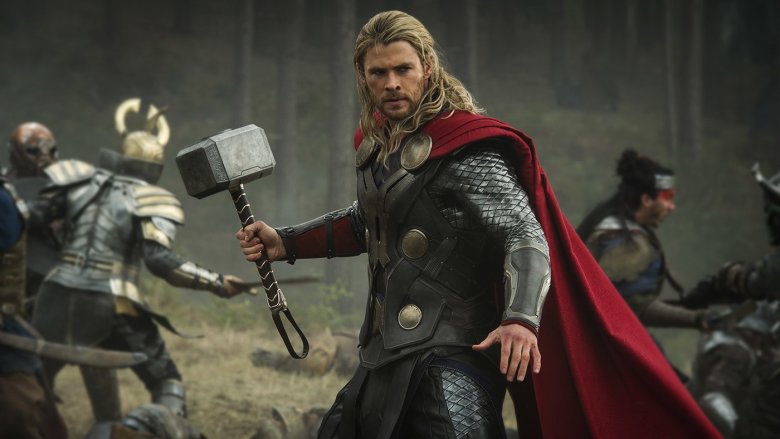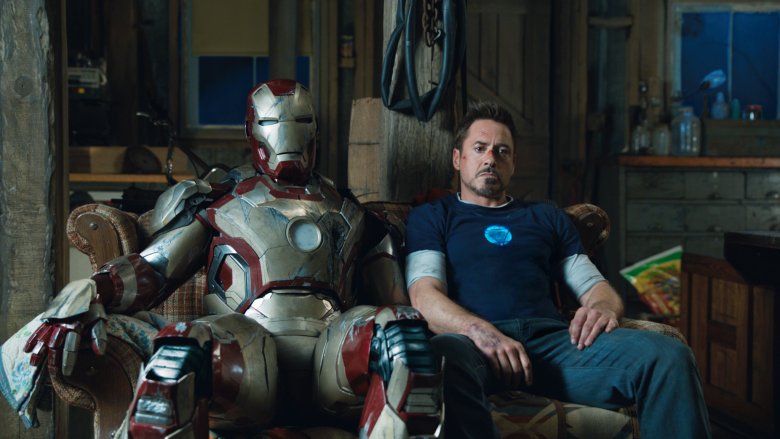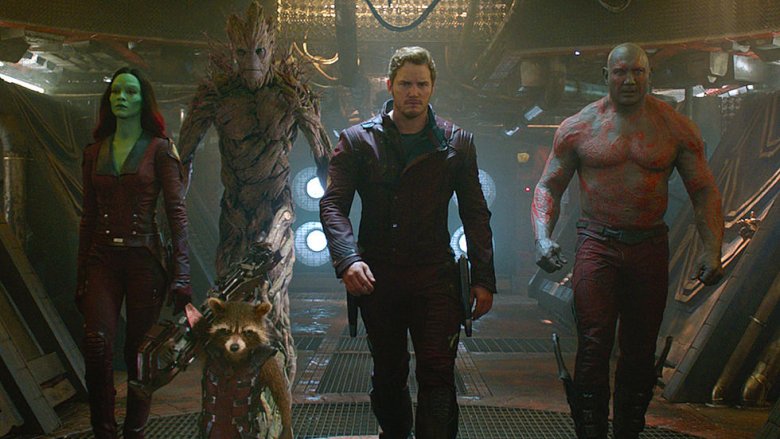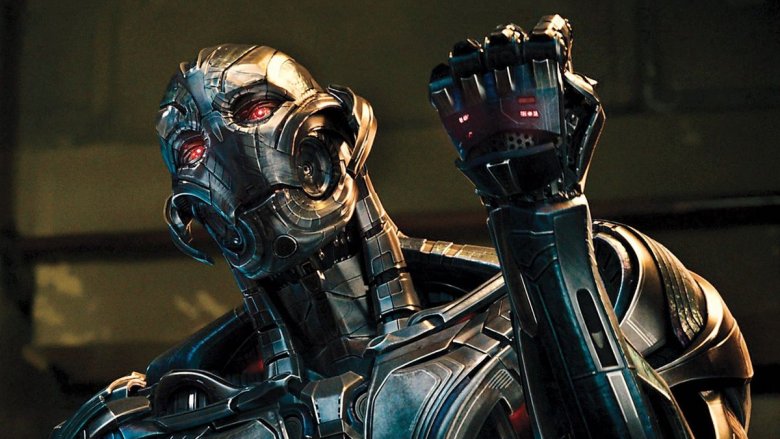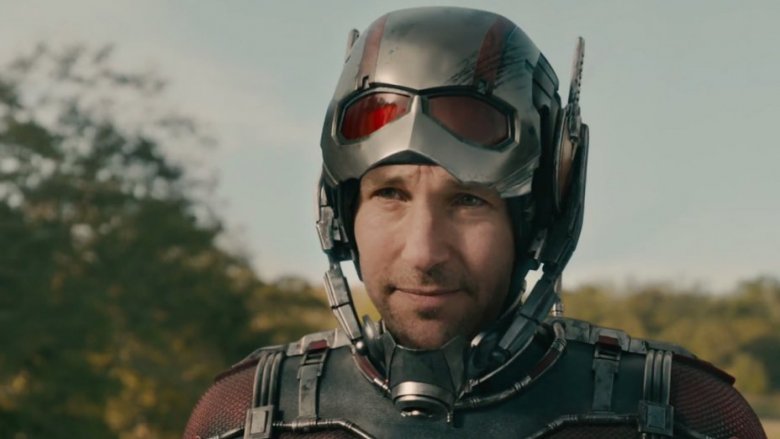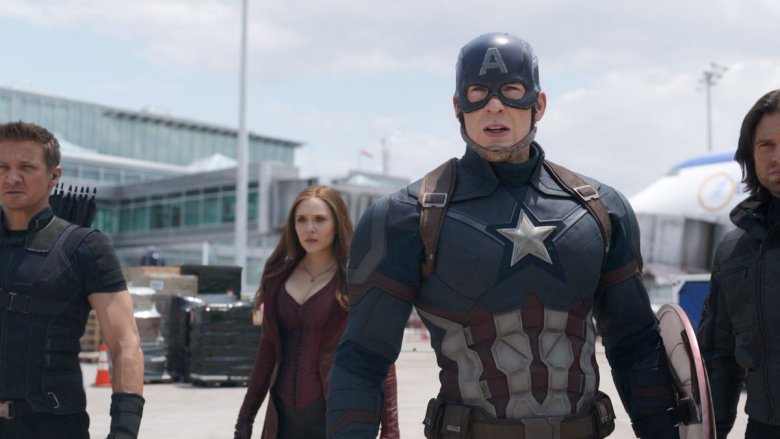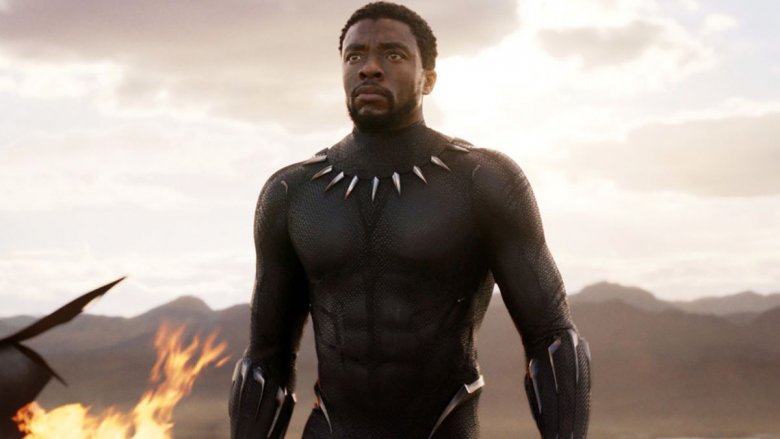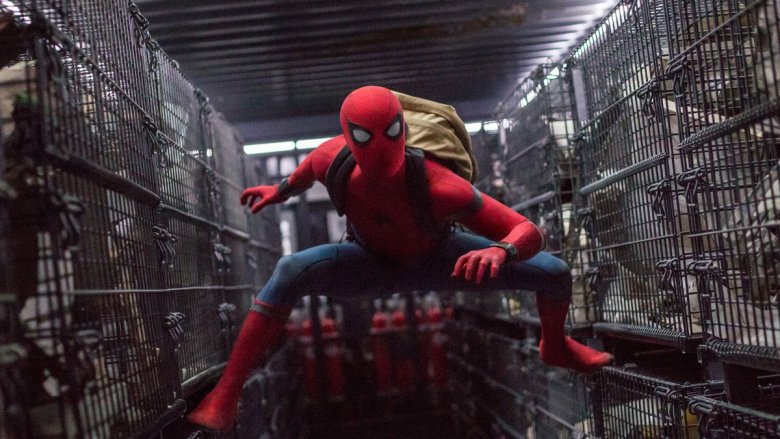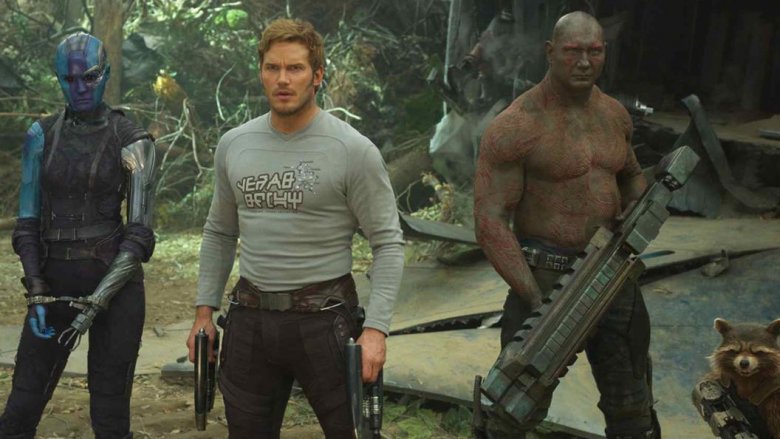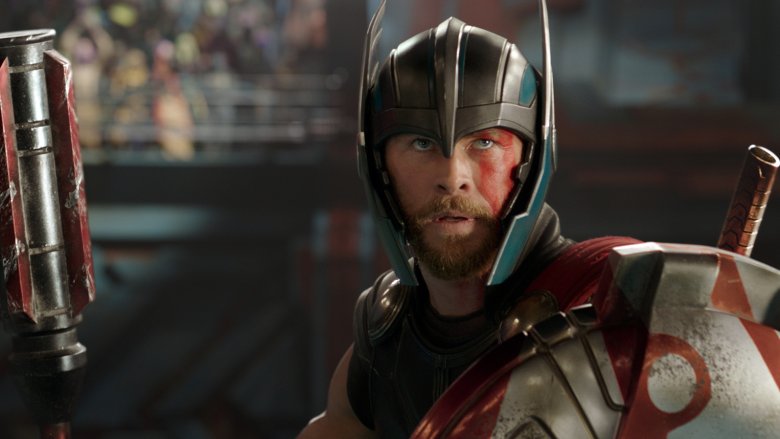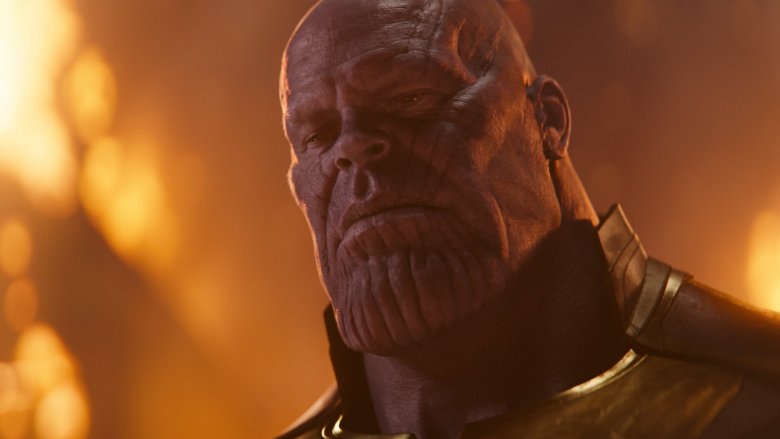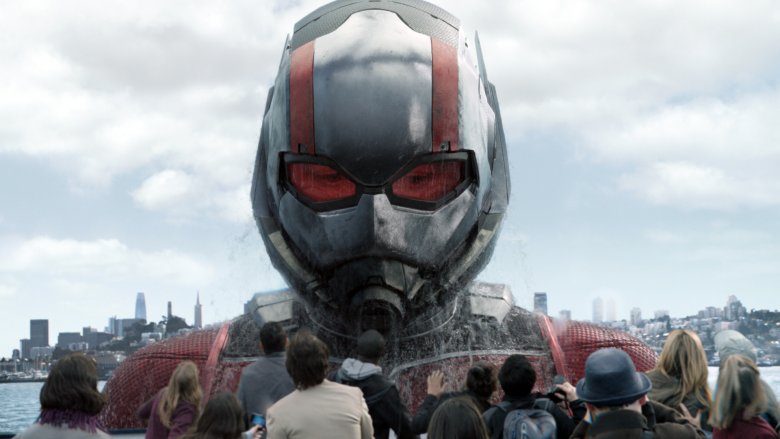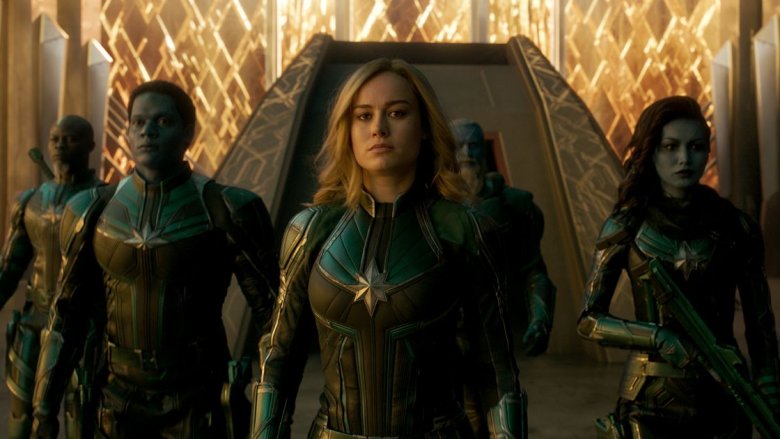This Is The Right Order To Watch Every MCU Movie
With the MCU turning 22 films old upon the upcoming release of Avengers: Endgame, a lot of fans are using their expertise to guide others through Marvel Studios' timeline. Some of them argue the correct way to binge Marvel's movies is chronologically by when the respective films' events took place. That makes 2011's Captain America: The First Avenger the first film to watch, even though it was the fifth MCU movie to be released.
While we don't necessarily buy the idea that watching the MCU movies in order of release is the best way to go, we also don't agree that watching them like a historical timeline makes sense either. We asked ourselves what order made the most sense in terms of story flow — rather than just asking, "when did stuff happen?" — and as a result, we have what we think is the right order to watch every MCU movie.
Iron Man (2008)
Captain America: The First Avenger may be first Marvel Studios story by History Channel reckoning, but the MCU was born with 2008's Iron Man. Just like Pepper's gift to Tony — his first miniaturized arc reactor mounted and engraved with the words "Proof that Tony Stark has a heart" — Iron Man made Robert Downey Jr. and his genius billionaire playboy philanthropist the beating heart of Marvel Studios' narrative.
Almost everything we associate with MCU films begins here: the origin story of the deeply flawed hero, the graceful interweaving of elements from the larger Marvel narrative, and of course the compulsory post-credits scene teasing larger things to come. Even if it's not the first event in the timeline, the birth of the narrative was Iron Man, and no Marvel movie marathon should begin with anything else.
Iron Man 2 (2010)
The Incredible Hulk hit theaters two years before Iron Man 2, but there are a couple of reasons why you should watch Tony and Rhodey take out Whiplash's drones before Ed Norton's lone MCU feature.
First, while we're not in love with the idea of watching things in an "as they happened" order, the events of Iron Man 2 mostly take place before Incredible Hulk. Judging by news footage of the Hulk's rampages seen in the background of the film's penultimate scene — when Nick Fury gives Tony his "Avengers Initiative" evaluation — there is some overlap between the two movies' timelines.
Second and more importantly, with Tony agreeing to be a S.H.I.E.L.D. consultant at the end of Iron Man 2, watching in this order helps make sense of his appearance at the end of the one and only MCU film with no post-credits or mid-credits scene.
The Incredible Hulk (2008)
Instead of having a mid or post-credits scene, The Incredible Hulk features a short final scene which cemented the idea that it was part of a larger Marvel narrative. As General Ross drowns his sorrows in a bar, Tony Stark appears, claiming to have an answer to Ross' problems.
The scene eventually needed a retcon. It seems likely, considering the tenor of Ross and Stark's conversation, that originally the plan was to follow the trajectory of the comics and have the origin of the Avengers begin with a hunt for the Hulk. After plans changed, the Ross/Stark scene stuck out like a sore thumb.
Marvel's solution was to release the short film "Marvel One-Shot: The Consultant" on the Thor Blu-ray, featuring two conversations between S.H.I.E.L.D. agents Phil Coulson and Jasper Sitwell before and after Incredible Hulk's final scene, reframing it so that it made some kind of sense.
Thor (2011)
Agent Coulson exits the story of Iron Man 2 when a S.H.I.E.L.D. assignment calls him to New Mexico. We catch up with him after the credits as he locates Thor's hammer in the desert, marking the first time a Marvel post-credit scene directly overlapped with an upcoming film. It's one of the reasons shifting Iron Man 2's placement helps with any marathon — otherwise, Thor follows Iron Man 2 immediately. This way, you get the tease of the hammer at the end of Iron Man 2 and have to wait through Incredible Hulk for the payoff.
Thor is another reason why watching the films "chronologically" isn't necessarily the best way. Thor and Captain America should be watched back-to-back. First, because they contrast each other wonderfully; you go from Asgardian gods to World War II historical fiction. Second, each has an early scene set in Tonsberg, Norway. Most importantly, the two movies — both released in the summer of 2011 — worked together to launch the MCU to new cosmic realms with a basic concept: that science and magic could be seen as "one and the same."
Captain America: The First Avenger (2011)
Captain America: The First Avenger is fine right where it is. Don't let anyone tell you differently.
There are the connections we already mentioned between Captain America and Thor. But more than that, there's what happens to Cap at the end of the film. After Steve Rogers has spent the bulk of the movie's runtime fighting in World War II, he's abruptly transported to the present. Without us already being familiar with the Marvel Universe, that's a pretty silly ending. Without the MCU as context, it might feel like the writers just got stuck and just ended the script the craziest way they could.
Then there's Howard Stark. It turns out Tony's father is integral to the history of Captain America, something that becomes pretty important during Civil War. Howard's a fine character on his own, but the novelty of getting to meet him is lost unless we've already met his son.
Avengers (2012)
No matter where you'd put those first five Marvel Studios films, 2012's Avengers belongs at the end of them. There is something uniquely satisfying about watching all five of the first MCU movies and then seeing so many characters from all the respective flicks united in Avengers.
That satisfaction works against the "chronological" watching of the films in a couple of ways. On one hand, Avengers belongs right after Captain America because of the importance the Tesseract plays in both, and because of how much Cap's "man out of time" theme informs his arc in Avengers.
On the other hand, Carol Danvers is nowhere to be seen in Avengers. A chronological viewing would place 2019's Captain Marvel in the #2 spot, making her the only hero with her own film you'd watch before Avengers who wouldn't be in Avengers. That would make the team's first heroic assembly feel needlessly incomplete.
Captain America: The Winter Soldier (2014)
While Captain America: The Winter Soldier was released after Iron Man 3 and Thor: The Dark World, there is one really good reason to watch it first.
One of the more valid criticisms of Marvel Studios' second phase is that there were no Avengers assembling, even as each of the heroes found themselves in need of a little help from their friends. The Avengers assemble to eliminate a Hydra base in Age of Ultron, but not to save the U.S. President in Iron Man 3 or the universe in The Dark World? Tony Stark asks Bruce Banner to give him a therapy session but not to help fight the Mandarin?
The Winter Soldier offers an explanation. The film — which could easily be seen as overlapping with the rest of Phase 2's rapid-fire action — ends with the disbandment of S.H.I.E.L.D., which brought the Avengers together in the first place. Without Nick Fury to help, coordination between Avengers may have been more difficult, hence Thor and Tony going solo.
Thor: The Dark World (2013)
The first three MCU films to follow The Avengers happen more or less concurrently, and one could argue the three could be watched in any order.
But we would argue that The Dark World needs to stay where it is. You can't push it too far down the order, because it's the first time we see Loki answering for his crimes against Earth, and waiting three or four films for that would seem strange. You guys are just getting around to sentencing Loki now? We thought Asgard was high tech... how long do mug shots take there?
It also can't come immediately after Avengers. The Dark World shows us the aftermath of Jane Foster learning that Thor came to Earth to fight the Chitauri but didn't bother to drop her a line before or after. Coming hot on the heels of Avengers, her anger might seem a little strange.
Iron Man 3 (2013)
One of the most important aspects of Iron Man 3 is the portrayal of Tony's PTSD. It sets up why Tony is willing to risk so much in Age of Ultron. Giving two movies of space in between Avengers and Iron Man 3 is helpful, showing that Tony has unfortunately had some time for his trauma to simmer.
Iron Man 3 also may be the best reason to make sure Winter Soldier comes first in your Phase 2 viewing. In Iron Man 2 we saw S.H.I.E.L.D. plant a spy in Stark Industries. Nick Fury personally intervened with Stark's shenanigans, and Tony was put under house arrest until he could find a cure for his own Palladium poisoning.
But in Iron Man 3, Tony threatens an infamous terrorist and his home is destroyed — not to mention the President of the United States getting kidnapped — and that doesn't rate as high on the S.H.I.E.L.D. priority list as "Iron Man spending a hangover in a doughnut?"
Guardians of the Galaxy (2014)
At first there wasn't much tying Guardians of the Galaxy to the rest of the MCU. The only tangible connection was the brief appearance of Thanos, who'd been introduced during the credits of The Avengers. The Mad Titan is also the reason why you should make sure to keep Guardians exactly where it is in the watching order.
Avengers: Age of Ultron's mid-credits scene shows Thanos grabbing what appears to be the Infinity Gauntlet and — apparently frustrated with the Stones continuing to slip through his fingers — saying, "Fine. I'll do it myself."
The line marks the end of Thanos' strategy of getting the Infinity Stones through intermediaries. The films reflect that — the Infinity Stones are scarce in Phase 3, and when they do show up (in Doctor Strange and Civil War), no one is trying to capture them. If Guardians doesn't stay before Age of Ultron, Thanos' mid-credits proclamation makes no sense.
Avengers: Age of Ultron (2015)
Avengers: Age of Ultron's spot is a pretty solid no-brainer. The dissolution of both S.H.I.E.L.D. and Hydra, as well as Maria Hill's career move to Stark Industries, both happen in Winter Soldier. We see the results of Stark's trauma in Iron Man 3, which in Age of Ultron push him to create Ultron in secret, with devastating consequences. Finally, Thor's knowledge of the Infinity Stones in Ultron comes, in part, from his experiences in The Dark World.
The only other thing to remember is that you can't shove Ant-Man before Age of Ultron. When Scott Lang suggests contacting the Avengers, Hank Pym's snide response about the heroes being busy "dropping cities out of the sky" is an obvious reference to the climax of Age of Ultron. Plus, Lang's dust-up with the Falcon in Ant-Man shows Sam Wilson in his post-Ultron outfit.
Ant-Man (2015)
As the final film of Marvel Studios' Phase 2, Ant-Man is firmly set between Avengers: Age of Ultron and Captain America: Civil War. We know it happens after Age of Ultron, both because of Hank Pym's comments about the battle in Sokovia and because when Scott Lang tussles with Falcon, the latter is in the same get-up we saw him in for the first time at the end of the second Avengers film.
We know it takes place right before Captain America: Civil War because Ant-Man ends with Scott Lang learning Falcon is looking for him, and in Civil War we find out why — recruitment to Team Cap. Ant-Man's sequel gets quite a bit trickier to place, but we'll get to that in a bit.
Captain America: Civil War (2016)
Like Ant-Man and Age of Ultron, there isn't anything too complicated to figure out about the placement of Captain America: Civil War. What gets tricky is what comes after.
Civil War not only splintered the heroes of the MCU, it added two brand new names — Black Panther and Spider-Man — to the narrative's roster. Between Civil War and the end of Phase 3, four new properties would premiere their freshman films — Black Panther, Spider-Man: Homecoming, Doctor Strange, and Captain Marvel — and Avengers: Infinity War brought more heroes together from different franchises than any previous flick. Not to mention Ant-Man and the Wasp, Captain Marvel, and Guardians of the Galaxy Vol. 2 each complicating the idea of chronological viewing in their own way.
But as you'll see, we have some ideas.
Black Panther (2018)
While it didn't come out in theaters until after Doctor Strange, Guardians of the Galaxy Vol. 2, Spider-Man: Homecoming, and Thor: Ragnarok; 2018's Black Panther belongs shortly after Captain America: Civil War. The events of Civil War lead directly to Black Panther. While not all MCU fans are on board with chronological viewing, few would disagree that waiting four films and two years between Black Panther and Civil War feels far too long.
The death of T'Chaka at the hands of Zemo in Civil War is what sets off everything in Black Panther. T'Challa's ascension to the throne, M'Baku's challenge and subsequent alliance, and the return of Nakia to Wakanda all spring from that fateful event. While Erik Killmonger's crusade to seize the throne might not have changed, it seems unlikely — were he still alive — that the older T'Chaka would have accepted the younger man's challenge as T'Challa does.
Spider-Man: Homecoming (2017)
Watching Homecoming in order of release makes the film feel strange. The Spider-Man of Homecoming already feels disconnected from the larger story, and the fact that the film is sandwiched between two big space epics doesn't help.
Like Black Panther, Spider-Man: Homecoming follows directly from Captain America: Civil War. We even revisit some of Civil War in Homecoming, via Peter Parker's personal video diary about his recruitment to Team Iron Man and the explosive airport battle in Leipzig. It's also good to keep at least one movie between Homecoming and Civil War, because the end of Homecoming sees the return of Pepper Potts. During Civil War, we learned that Pepper and Tony were "taking a break," while in Homecoming they seem perfectly happy with one another. Whatever resolved their issues needed time, and if you watch in our order, Black Panther provides a nice speed bump.
Guardians of the Galaxy Vol. 2 (2017)
There was a lot of noise after Guardians of the Galaxy Vol. 2's release about Stan Lee's cameo — in which he mentioned his cameo in Civil War — going against James Gunn's claims that the actual timeline of the film placed it before Civil War.
Our advice? It all takes place in space. None of the Avengers are in it. Forget about it and watch Baby Groot dance.
No, Guardians of the Galaxy Vol. 2 goes here not because of any chronology glitches, but because with only two other films left before Avengers: Infinity War — and one of those films is Thor: Ragnarok, which is easily more similar to Guardians in tone and scope than any other MCU film — we didn't want two witty, snarky, intergalactic epics back-to-back.
Doctor Strange (2016)
We don't know much chronologically about Doctor Strange, although he's mentioned briefly in Captain America: The Winter Soldier, and by the time Thor: Ragnarok rolls around, we find Strange fully situated as a Master of the Mystic Arts.
Agent Jasper Sitwell's mention of Strange in Captain America: The Winter Soldier remains an unfortunate mystery — the double agent says Strange's name in a list of targets that would potentially be murdered by Hydra's Project: Insight. Strange was still a neurosurgeon at that point. Since Arnim Zola's brainchild was supposedly able to predict future behavior, perhaps we can assume the algorithm somehow knew Strange would eventually become a bigger pain in the butt to all the right people.
But forget the chronology here. Yes, it has to take place before Thor: Ragnarok and yes, Sitwell mentions Strange's name in a list of targets for Project: Insight during The Winter Soldier. But Doctor Strange's placement mainly serves to break up two space-based flicks: Guardians of the Galaxy Vol. 2 and Thor: Ragnarok. And considering Doctor Strange's mid-credits scene is in fact a little slice of Ragnarok, it's nice to get those two movies back to back.
Thor: Ragnarok (2017)
When fans saw Ragnarok's mid-credits scene in theaters, it was difficult to imagine the approaching shadow was from anything but Thanos' ship. We all had to wait until after Black Panther to find out we were right, but at the time it was an almost cruelly tantalizing tease.
Now that we've seen Avengers: Infinity War and we know the brutal fate awaiting Loki, Heimdall, and so many other doomed passengers, it's a little bizarre to not watch Ragnarok and Infinity War back-to-back. The first thing we hear in Infinity War is the Agardian refugee ship's distress call, and the battle is over before we get to see the inside of the vessel. To have a two-hour film like Black Panther separate the approach of Thanos and the aftermath of his assault? No, that's too weird.
Avengers: Infinity War (2018)
And finally, the Big One. Avengers: Infinity War is the beginning of the end of the story that started as soon as the Red Skull got his dirty Nazi mitts on the Tesseract in Captain America: The First Avenger.
Marvel Studios put some unbelievable time, effort, and money towards the build-up to (and execution of) Avengers: Infinity War, and you have to believe they had a reason to release it when they did. Yes, they've tortured us by putting two movies between Infinity War and its resolution in Endgame. But while tastes always vary, we don't think the MCU has put out any real stinkers, so they've earned the benefit of the doubt. Surely, the teasing and the torture from Marvel has all been tough love, and there's no reason to move Infinity War from the order a single inch.
Ant-Man and the Wasp (2018)
For the most part, Ant-Man and the Wasp takes place at the same time as Avengers: Infinity War, and in the mid-credits scene we see proof of that, as the Pyms become victims of Thanos' purge. Because of this, a chronological reading might suggest moving this before Infinity War, but that's unwise for a couple of reasons.
For one thing, it gives away the ending of Infinity War! Sure, if you're enough of a Marvel fan that you're willing to marathon all the movies, then you probably already know how Infinity War ends. But still, it's like watching Civil War before Winter Soldier. It's silly.
Second, and way more importantly, Infinity War is a downer. After watching Peter Parker turn into the bottom of an ashtray, you need laughter. You need Paul Rudd's snark. You need stories told in a way that only Michael Peña's Luis can tell them. You need Ant-Man and the Wasp.
Captain Marvel (2019)
Because Captain Marvel is set in the '90s, with the Blockbusters and alt-rock t-shirts to prove it, the chronological crew would move this all the way to Phase 1 of the MCU — in the number two spot, following Captain America: The First Avenger. You can do that if you want, but we have a feeling the biggest victim will be your appreciation for Avengers: Endgame.
The first meeting between Carol Danvers and the Avengers is sure to be a huge, crowd-pleasing moment in the theater, filled with applause and cheers. Do you think that would be the case if Marvel told these stories in chronological order, and so gave us a Captain Marvel story twenty films ago and then never mentioned her again? Or do you think that moment would instead be remembered for all the people whispering, "Who the hell is that?"
There are reasons why Pulp Fiction earned accolades and awards. Sometimes, for a story to make any kind of sense, you have to tell it out of order.
